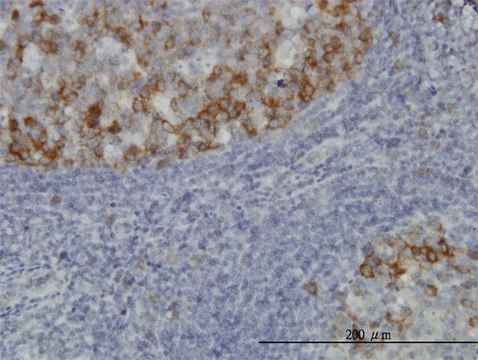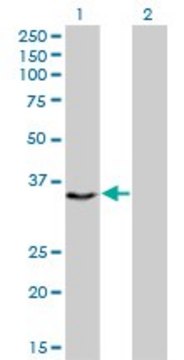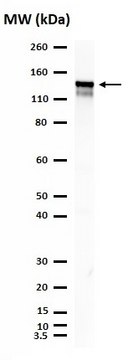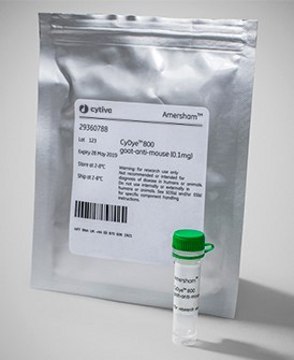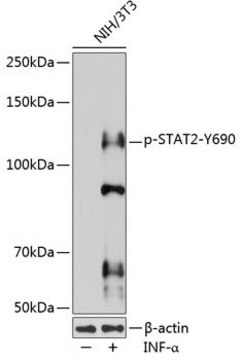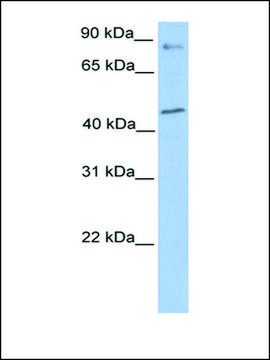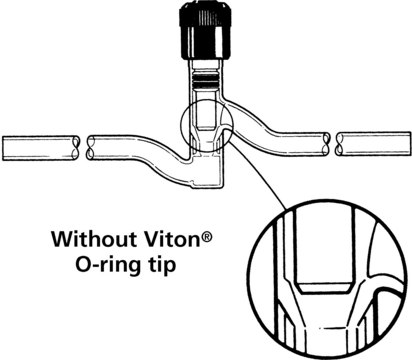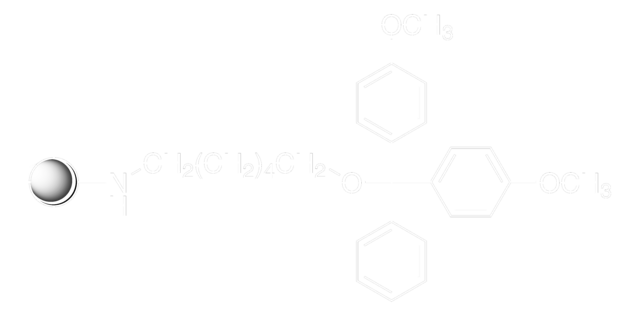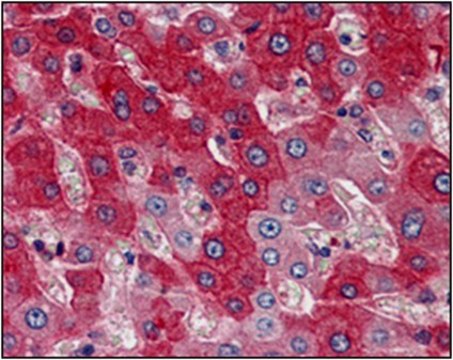推荐产品
生物来源
mouse
质量水平
抗体形式
purified immunoglobulin
抗体产品类型
primary antibodies
克隆
8G1, monoclonal
种属反应性
human
制造商/商品名称
Chemicon®
技术
immunocytochemistry: suitable
western blot: suitable
同位素/亚型
IgG1
NCBI登记号
UniProt登记号
运输
wet ice
靶向翻译后修饰
unmodified
基因信息
human ... BUB1B(701)
一般描述
The mitotic checkpoint prevents the resulting two daughter cells from having unequal numbers of chromosomes. This condition, known as aneuploidy, is present in almost all cancer cells and may be due to malfunctions in the mitotic checkpoint. BubR1 is a mitotic checkpoint kinase and has been implicated in the metaphase checkpoint control in mammalian cells.
特异性
Recognizes human BubR1.
免疫原
Recombinant human BubR1.
应用
Detect BubR1 with Anti-BubR1 Antibody, clone 8G1 (Mouse Monoclonal Antibody), that has been shown to work in WB, ICC.
Western blot using an ECL detection system. Reacts with the ~120 kDa BubR1 protein and higher bands due to hyperphosphorylations.
Immunocytochemistry: 1 μg/mL on tissue culture cells. Suggested fix is 3.5% PBS-buffered paraformaldehyde for 7 minutes. Permeabilization method is 0.2% Triton-X-100 after fixation. Suggested blocking buffer is 10 mM Tris, pH 7.5 with 150 mM NaCl with 0.1% BSA.
Optimal working dilutions must be determined by the end user.
Immunocytochemistry: 1 μg/mL on tissue culture cells. Suggested fix is 3.5% PBS-buffered paraformaldehyde for 7 minutes. Permeabilization method is 0.2% Triton-X-100 after fixation. Suggested blocking buffer is 10 mM Tris, pH 7.5 with 150 mM NaCl with 0.1% BSA.
Optimal working dilutions must be determined by the end user.
外形
Format: Purified
其他说明
Concentration: Please refer to the Certificate of Analysis for the lot-specific concentration.
法律信息
CHEMICON is a registered trademark of Merck KGaA, Darmstadt, Germany
未找到合适的产品?
试试我们的产品选型工具.
储存分类代码
10 - Combustible liquids
WGK
WGK 2
闪点(°F)
Not applicable
闪点(°C)
Not applicable
Subcellular localization of the spindle proteins Aurora A, Mad2, and BUBR1 assessed by immunohistochemistry.
Burum-Auensen, E; De Angelis, PM; Schj?lberg, AR; Kravik, KL; Aure, M; Clausen, OP
The journal of histochemistry and cytochemistry : official journal of the Histochemistry Society null
Linda Clijsters et al.
Cell cycle (Georgetown, Tex.), 13(15), 2370-2378 (2014-12-09)
Sister chromatid separation creates a sudden loss of tension on kinetochores, which could, in principle, re-activate the spindle checkpoint in anaphase. This so-called "anaphase problem" is probably avoided by timely inactivation of cyclin B1-Cdk1, which may prevent the spindle tension
David J Wynne et al.
Molecular biology of the cell, 27(22), 3395-3404 (2016-11-05)
The kinetochore is often depicted as having a disk-like architecture in which the outer layer of proteins, which engage microtubules and control checkpoint signaling, are built on a static inner layer directly linked to CENP-A chromatin. Here, applying three-dimensional (3D)
Kinetochore function is controlled by a phospho-dependent coexpansion of inner and outer components.
David J Wynne et al.
The Journal of cell biology, 210(6), 899-916 (2015-09-09)
It is widely accepted that the kinetochore is built on CENP-A-marked centromeric chromatin in a hierarchical order from inner to outer kinetochore. Recruitment of many kinetochore proteins depends on microtubule attachment status, but it remains unclear how their assembly/disassembly is
Eric C Tauchman et al.
Nature communications, 6, 10036-10036 (2015-12-02)
During mitosis, duplicated sister chromatids attach to microtubules emanating from opposing sides of the bipolar spindle through large protein complexes called kinetochores. In the absence of stable kinetochore-microtubule attachments, a cell surveillance mechanism known as the spindle assembly checkpoint (SAC)
我们的科学家团队拥有各种研究领域经验,包括生命科学、材料科学、化学合成、色谱、分析及许多其他领域.
联系技术服务部门